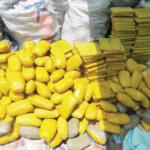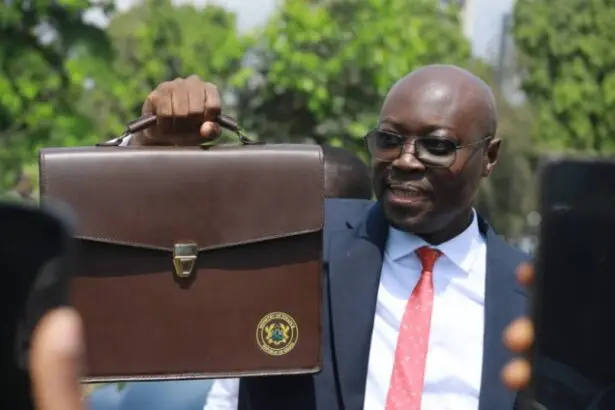This week, my guest columnist is Mr. Emmanuel Amoah-Darkwah, an economist and a partner at C-Kadd Global.
He shares his observations on what government supporters have termed ‘Agyenkwa Budget’.
The 2022 budget is themed ‘Building a Sustainable Entrepreneurial Nation: Fiscal Consolidation and Job Creation’ and is expected to consolidate the macroeconomic gains achieved post COVID-19 pandemic while addressing short to medium-term risks to the economy.
Fiscals
On revenue, the government has projected to raise GH¢100.5 billion in total revenue and grants in 2022 compared to GH¢ 72.4 billion in 2021.
As at the end of September 2021, provisional total revenue estimates stood at GH¢47.2 billion compared to the GH¢51.3 billion programmed.
The revenue target for 2021 is likely to be missed should tax compliance derail. Government envisages increasing revenue as a percentage of GDP from 16 per cent in 2021 to 20 per cent in 2022.
Key revenue measures include the imposition of an Electronic Transaction Levy of 1.75 per cent on the value of digital transactions and exempting daily transactions up to GH¢100 and increment of fees and charges by 15 per cent.
The government’s revenue mobilisation drive is not ambitious enough to grow the direct tax-paying population from the current 2.3 million out of 12.9 million labour force.
On expenditure, the government expects to spend GH¢137.5 billion, including arrears in 2022, compared to GH¢113.7 billion in 2021.
In 2022, the budget deficit is expected to reduce to GH¢37 billion from GH¢41.3 billion in 2021. This is in line with the medium target of achieving the budget deficit target of less than five per cent to GDP in accordance with the Fiscal Responsibility Act 2018 (Act 982).
Domestic financing estimate for the end of September 2021 reached GH¢20,388 billion compared to a projected estimate of GH¢14,061 billion.
This trend is worrying as the government is actively crowding out the private sector for credit.
Public debt hit GH¢341,762.7 million (US$58,239.8 million) as at end-September 2021.
Ghana’s public debt is rising steadily. From a nominal public debt stock of GH¢122.2 billion in 2016, it rose to GH¢ 291.6 billion by the close of December 2021.
Despite the fiscal challenges posed by the COVID-19 pandemic, financial sector clean-up and energy sector debt, Ghana’s debt and its accompanying high interest rate could trigger macroeconomic instability in the medium term.
Interest payment for the second year in a roll leads expenditure allocations.
Interest payment is projected at GH¢37,447 million (7.5 per cent of GDP) followed by Compensation of Employees projected at GH¢35,841 million (7.1 per cent of GDP) and Grants to other government units at GH¢ 26,828 billion. Capital Expenditure (CAPEX) is projected at GH¢16,396 million (3.3 per cent of GDP).
With the infrastructure financing needs of the country, CAPEX allocation should double in the medium term to enhance productivity and make Ghana competitive in attracting investment.
Sectorial developments
The Services sector continues to be the main driver of Ghana’s GDP, followed by industry and agriculture.
The Services sector recorded a growth rate of 7.2 per cent in the first half of 2021 compared to 2.3 per cent last year. Industry, however, contracted by 1.3 per cent mainly resulting from the significant derailment in growth in the mining and quarrying subsectors, which fell by 11.2 per cent and 18.9 per cent, respectively.
A main contributor to the contraction was the -13.4% growth in the oil sub-sector due to low production.
To spur growth in the oil and gas sector, the government must structure policies to ensure maximum economic recovery from petroleum resources, especially in the wake of the global energy transition agenda. In addition, corporate tussles within the sector like the ENI/Springfield tussle must be resolved quickly to make the sector attractive.
E-Levy
The e-levy of 1.75 per cent is expected to generate GH¢6,963,386,254 billion in 2022. According to the government, Ghanaians who transact below GH¢100 a day average 40 per cent; hence it will not negatively affect the poor.
Government should further engage with stakeholders to review the levy and explore other revenue generation measures such as curbing illicit financial flows and corruption.
There is evidence from studies conducted in Kenya and Tanzania that goes to suggest a likely reversal to cash transactions by citizens in a bid to avoid taxes that are deemed extortive.
The gains made from creating a formal banking system to foster inclusion for persons within the informal sector is likely to be eroded by the new levy.
Retail transactions that require e-payment methods could experience sharp decline in the coming year. This will be in contravention of the government’s promise to create a cashless economy.
Benchmark valuation
The reversal of Benchmark Values by 50 per cent on selected general goods and 30 per cent discount on vehicles will likely reduce the competitiveness of Ghana’s port.
The high import duty is not the only component making Ghana’s port uncompetitive. Government should review all other cost components at the port to make Ghana’s port competitive among the ports in the sub-region.
In the short-term, prices of imported goods will increase steadily. On the other hand, the government should be committed to import substitution industrialisation, which is the surest way to grow the economy.
The reduction of withholding tax on sale of unprocessed gold by small-scale miners from three per cent to 1.5 per cent will positively impact the industry and to a large extent help to curtail the smuggling of gold.
Road tolls
Government in an effort to reduce travel time and vehicular traffic on roads has removed road tolls.
It will, however, compensate for the loss in revenue through an imposition of e-levy of 1.75 per cent on electronic transitions, in respect of which I have already shared my observations.
‘YouStart’ initiative
It is commendable government’s quest to support youth entrepreneurs with up to GH¢10 billion together with its partners in the medium term.
As trading under the African Continental Free Trade Area (AfCFTA) progresses steadily, youth entrepreneurs can take advantage of the market size of 1.2 billion people with a combined GDP of US $ 2.5 trillion.
Going forward
The 2022 budget attempts to resolve the structural problem of widening the tax net but there remains a lot of work to be done in this area.
Rationalisation is a prudent option to reduce budget deficit and high public debt. Going forward, broader stakeholder consultations are needed in the future before arriving at policy options.
















